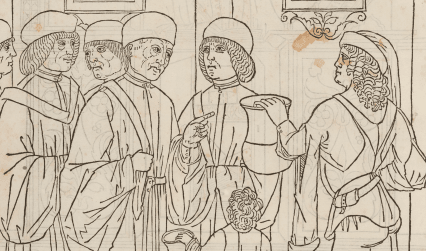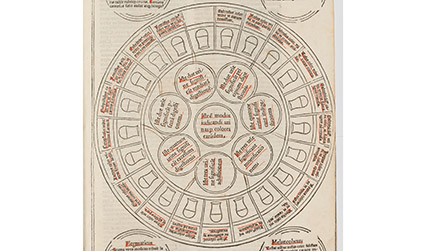In a world without x-rays, blood tests or even the stethoscope, medieval physicians had to rely on other means to attempt diagnoses. One of the most important of these was diagnosis by examination of the urine, known as uroscopy.
A rare book acquired by the library contains a beautiful and practical guide to diagnosis by urine. The book is an edition of Fasciculus medicinae attributed to Johannes de Ketham, printed in Venice in the year 1500. Fasciculus medicinae is a compendium of short medical texts. These texts had circulated in manuscript copies for many years before the first printed version appeared in the year 1491.
In total there are ten full-page woodcut illustrations in the book, covering all manner of medical topics: bloodletting, wounds and their treatments, disease, the influence of the zodiac on the body, female anatomy, the plague, and dissections. Uroscopy takes centre stage in this book, with two images devoted to it on the first double-page spread.

On the left-hand side, patients gather round a physician holding up their samples in glass urine jars. On the right-hand side is a urine wheel. At the edge of the wheel are 20 descriptions of the colour and characteristics of the urine samples. Inside this are representations of urine flasks. The flasks fall into seven categories according to what they indicate about the patient’s health. The central roundel gives the title of the diagram: ‘this is the method of diagnosing by the colours of urines’.

The following pages of text explain uroscopy in more detail. They describe how urine was thought to reveal imbalances of the four humours (blood, yellow bile, black bile and phlegm) and then explain the diagnoses that can be made from each sample. As today, not only the colour, but also the consistency, clarity and the presence of sediment all contributed to the physician’s diagnosis, although the conclusions drawn were often radically different. According to the Fasciculus, for example, black urine indicates that the natural heat of the body has been extinguished, which will be fatal to the patient.
The RCP acquired this book with generous support from the Arts Council PRISM fund. It was the subject of a lecture by Peter Murray Jones on Monday 19 May 2013. The book is available for research and consultation in the library reading room.
Katie Birkwood, rare books and special collections librarian
